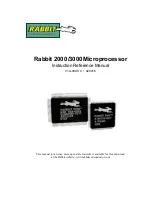
3-28
CB3000 Client Bridge User’s Guide
•
MD5
– The MD5 authentication method takes a message of arbitrary length as input and produces
a 128-bit fingerprint. The MD5 algorithm is intended for digital signature applications, in which a
large file must be compressed in a secure manner before being encrypted with a private (secret) key
under a public-key cryptographic system.
•
MSCHAPV2
– Microsoft Challenge Handshake Authentication Protocol Version 2. MS-CHAP-v2
[RFC2759] is an extension of, yet incompatible with, MSCHAPv1. It also supports mutual
authentication.
MSCHAPV2 is the default authentication method used by the Microsoft Windows
2000 operating system. Support of this authentication method on the CB3000 enables Windows
2000 users to establish remote PPP sessions without needing to first configure an authentication
method on the client. MSCHAP V2 introduces a change password feature, allowing the CB3000 to
change the account password if the RADIUS server reports the password has expired.
•
PEAP
– Windows XP SP1 and Microsoft 802.1X Authentication Client support Protected EAP (PEAP).
Uses an encrypted TLS-Tunnel. Only the server certificates are required.
•
TLS
– Transport Level Security is an EAP type that is used in certificate-based security environments.
If you are using smart cards for remote access authentication, TLS authentication is the method to
use.
•
TTLS
– Tunneled TLS. Requires certificate-based RADIUS server authentication, but supports an
extensible set of user authentication methods.
4. Use the
Default Transmit Key
checkboxes to specify which one key is used to transmit WEP algorithm
information between the CB3000 and its connected device.
5. Select either
64 bits
or
128-bits
from the
WEP Encryption
drop-down menu.
For WEP 64 (40-bit key), the keys are 10 hexadecimal characters in length. For WEP 128 (104-bit key), the
keys are 26 hexadecimal characters in length.
6. Select the
Passphrase Algorithm
used for encrypting the passphrase.
•
Symbol PassKey
– Symbol proprietary algorithm the CB3000 can share with other Symbol clients
capable of decoding it. The CB3000 decodes the PassKey into a set of 4 WEP keys using MD5
algorithms. The WEP keys display as alphanumeric text in the key fields until saved or the user
navigates away from the WEP screen. Like a passphrase, the PassKey provides an easy to remember
way of entering WEP key data without having to manually enter the keys each time WEP keys area
created.
•
Generic PassPhrase
–
A passphrase used as a standard means of creating WEP keys between the
Symbol CB3000 and non-Symbol clients. The CB3000 decodes the passphrase into a set of 4 WEP
keys, with the length depending on the 64 or 128 bit key length. The WEP keys display as
alphanumeric text in the key fields until saved or the user navigates away from the WEP screen. The
PassPharase provides an easy to remember way of entering WEP key data without having to
NOTE:
The CB3000 displays a read-only Cipher data which specifies the type of
data packet that follows it.
NOTE:
Both the CB3000 and its networked device are required to use the same
key and key length to interoperate.
Summary of Contents for CB3000 - Client Bridge - Wireless Access Point
Page 1: ...M CB3000 Client Bridge User s Guide ...
Page 24: ...2 12 CB3000 Client Bridge User s Guide ...
Page 65: ...Management Options 4 7 Figure 4 4 View Log Screen ...
Page 74: ...4 16 CB3000 Client Bridge User s Guide ...
Page 90: ...5 16 CB3000 Client Bridge User s Guide ...
Page 94: ...B 2 CB3000 Client Bridge User s Guide ...
Page 96: ...C 2 CB3000 Client Bridge User s Guide ...
Page 104: ...D 8 CB3000 Client Bridge User s Guide ...
Page 105: ......
















































